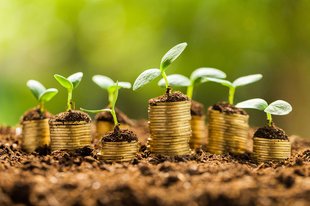What Are Green Bonds & Are They Investment-Worthy in 2025?
If you’re a savvy investor, conscious about climate change and environmental benefits, green bonds can be your next investment pick.
These bonds have shown exponential growth over the years, emerging as viable investment options for sustainable development.
In this article, we’ll cover all about green bonds, including what they are, how they work, and how green bond projects are selected. We’ll also explore their market growth and why you should invest in them.
Additionally, we’ll explore how wine investment through Vinovest is a worthy alternative to green bonds.
Further reading
- Curious about investing in fine wine? Here's a Comprehensive Guide on Wine Investment.
- Also, discover If You Should Invest in Bonds During a Recession.
What Are Green Bonds?

Green bonds are asset-linked, sustainable finance instruments used to raise money for environmental and climate projects. Since they’re usually backed by the issuer’s balance sheet, you’ll find they share the same credit rating as the issuer’s other debt instruments.
These bonds aim to encourage sustainability and specifically target two Sustainable Development Goals (SDG) – number 7 (affordable and clean energy) and number 13 (climate action.)
To achieve these goals, green bonds primarily focus on:
- Pollution control
- Energy efficiency
- Protection of ecosystems
- Clean transportation
- Clean water
- Carbon emission reduction
- Sustainable agriculture
- Sustainable water management
The European Investment Bank (EIB) issued the world’s first green bond in 2007. The following year, the World Bank issued the first labeled green bond for institutional investors.
But the green bond market has grown rapidly since then.
Today, besides the EIB and the World Bank, several global financial institutions are leading the race for green bond issuance (we’ll get to these in just a bit.)
Types of Green Bonds

Here are the five major types of green bonds:
- Standard Green Use of Proceeds Bond: The net proceeds of these green bonds are held in a sub-portfolio or tracked by the issuer. These bonds are aligned with the guidelines of the International Capital Market Association called the ICMA Green Bond Principles (GBP.)
GBP refers to the sustainability linked bond principles laid down in 2014 by a group of investment banks.
- Green Project Bond: This is a GBP-aligned, debt-obligation green bond issue specific to a single or multiple green projects. As an investor, you’ll be exposed to the associated risks of the project with or without potential issuer liability.
- Green Revenue Bond: This is a type of green bond issue in which the credit exposure is to the pledged cash of revenue streams, taxes, or fees. The green bond proceeds can be used for related or unrelated green projects.
- Green Securitized Bond: A green securitized bond can have one or more projects as collateral (asset-backed securities, covered bonds, and other structured investment options.) The first repayment is usually from the cash flows of underlying assets securing the sustainable bonds.
- Environmental Impact Bond (EIB): This green bond yields a return to investors depending on the project’s success in meeting its objectives. EIBs are usually small amounts of money issued to fund experimental or upcoming technologies with an investor and issuer sharing the reward and risk.
Green Bonds vs. Blue Bonds vs. Climate Bonds

While green bonds serve a range of environment-related projects, blue bonds and climate bonds are green bonds used for specific purposes.
Blue bonds are instruments used to finance ocean and associated ecosystem-based projects. These projects address issues like coral reef protection, reducing ocean acidification, sustainable fisheries, and more.
Climate bonds are used for projects dealing with climate change, such as reducing carbon emissions or mitigating the effects of global warming. These bonds are labeled by the Climate Bonds Standard and Certification Scheme of the Climate Bond Initiative.
How Does a Green Bond Work?

A green bond works in the same way as a government or corporate bond:
- The borrowers like the World Bank issue green bonds to obtain funding for environment-related projects like pollution reduction or climate change management.
- Investors like you purchase these bonds and can earn a profit when the bond matures. You can also secure tax benefits by investing in green bonds. Reputed issuers, who deliver sustained returns, help in boosting investor relations too.
How Are Green Bond Projects Selected?

The ICMA Green Bond Principles guide issuers in selecting projects for green bonds. These International Capital Market Association principles cover three primary considerations:
- Whether the project promotes environmental sustainability
- If the project falls under a “green project” category like renewable energy, carbon emission reduction, climate change control, energy efficiency, and so on
- Whether the project fulfills any additional eligibility or exclusion criteria applied to check and manage any risks associated with the project
Besides these sustainability linked bond principles, you can evaluate the credibility of a green project through the ‘second opinion’ of an external review agency.
Institutions undertaking green bond issuance can commission the agency for an external review to provide a second opinion about the green finance project.
Green Bond Market Growth

Green bonds are a relatively new sustainable finance instrument, but their cumulative issuance has crossed over a trillion dollars to date.
In 2012, the issuance of green bond proceeds amounted to just $2.6 billion. But according to Moody’s rating agency, it spiked to $161 billion by 2017. Though demand for green bonds decreased in 2018, issuance reached new heights in 2019 ($266.5 billion) and 2020 ($270 billion.)
Meanwhile, specialized sustainable bonds like climate bonds are issued by the Climate Bond Initiative and certified under the Climate Bonds Standard and Certification Scheme.
The green bond market expanded in the 2010s, with retail investors participating in more green ventures. Some of the leading sponsors of green bond mutual funds or ETFs include investment companies and asset management firms like:
- Blackrock (United States)
- Allianz SE (Germany)
- AXA World Funds (France)
- Axa SA (France)
- HSBC (United Kingdom)
- State Street Corporation (United States)
- TIAA-CREF (United States)
In 2019, the United States was the largest green bond issuer in the world (with a valuation of $50 billion), followed by the European Commission and China.
Note: The European Commission plans to launch the NextGenerationEU green bond program worth $250 billion over the next few years to become the world’s largest green bond issuer.
Why Invest in Green Bonds?

Unlike conventional debt instruments, green bonds have additional costs because issuers must keep track of net proceeds. However, you can offset the extra costs of green investments with several advantages like:
- Enabling investment and capital-raising for new and existing projects with environmental benefits.
- Offering tax incentives like tax credits and tax exemption makes them a better investment option than other taxable bonds.
- Leveraging the tax benefits to manage social issues such as climate change, controlling carbon emissions, and transitioning toward renewable energy sources.
- Building robust issuer and investor relations with sustained returns from a green finance project.
Green bonds are a smart option if you’re interested in protecting the environment.
But, if you’re keen to add an inflation-proof and recession-proof asset to your portfolio, then fine wine would be perfect for you!
Fine Wine Investment: An Alternative to Green Bonds

Fine wine is an extremely lucrative alternative investment choice.
Wine is a long-term investment play and offers you several advantages over traditional investment options and green bonds:
- Low volatility: The fine wine market regularly outperforms most global stocks and exchange-traded funds (ETFs) and is less volatile than gold or real estate.
- High returns: Over the last 15 years, wine investment has delivered 13.6% annualized returns.
- Inflation hedge: Wine helps diversify your investment portfolio and serves as a hedge against inflation.
- Stability: Wine investment manages any market volatility or sudden fluctuations.
If you’re keen to start investing in fine wine, check out the Vinovest website.
Vinovest is an AI-based wine investment platform that lets you buy, store and sell the best wines from around the world. Once you sign up, a wine expert will provide you with all the investment advice to build a profitable portfolio.
Invest in Wine for Handsome Long-Term Returns

Green bonds are a great investment option for the environment-conscience investor.
Green investments are also set to grow in the future, with world governments emphasizing the urgency of controlling climate change, reducing carbon emissions, and promoting sustainability.
But, if you want a less volatile, high-return investment, fine wine would be a great choice. It acts as a hedge against inflation, offering maximum returns at minimum risk.
To build a lucrative fine wine portfolio, sign up with the Vinovest and watch your fine wine collection grow.



